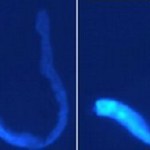Dying nematode worm. Image: Cassandra Coburn
Dr. Gems, University College London, and colleagues were studying aging using nematode worms. They discovered that dying nematode worms emit a wave of blue light from dying cells. It was previously thought that damaged components of aging cells collect in lysosomes forming what they call lipofuscin, which fluoresces. His team refuted that long-held belief and showed that the dying light was produced instead by anthranilate, a substance that is inactive in the acidic environment of the gut but becomes activated when cells die (necrosis) and…
Advertisment
